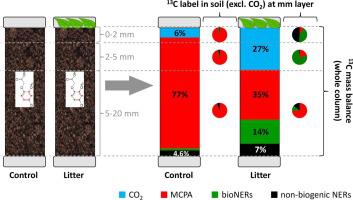Environment International ( IF 11.8 ) Pub Date : 2020-06-22 , DOI: 10.1016/j.envint.2020.105867 Karolina M Nowak 1 , Anja Miltner 2 , Christian Poll 3 , Ellen Kandeler 3 , Thilo Streck 4 , Holger Pagel 4

|
Amendment of soils with plant residues is common practice for improving soil quality. In addition to stimulated microbial activity, the supply of fresh soluble organic (C) from litter may accelerate the microbial degradation of chemicals in soils. Therefore, the aim of this study was to test whether the maize litter enhances degradation of 4-chloro-2-methylphenoxyacetic acid (MCPA) and increases formation of non-toxic biogenic non-extractable residues (bioNERs). Soil was amended with 13C6-MCPA and incubated with or without litter addition on the top. Three soil layers were sampled with increasing distance from the top: 0–2 mm, 2–5 mm and 5–20 mm; and the mass balance of 13C6-MCPA transformation determined.
Maize litter promoted microbial activity, mineralization of 13C6-MCPA and bioNER formation in the upper two layers (0–2 and 2–5 mm). The mineralization of 13C6-MCPA in soil with litter increased to 27% compared to only 6% in the control. Accordingly, maize addition reduced the amount of extractable residual MCPA in soil from 77% (control) to 35% of initially applied 13C6-MCPA. While non-extractable residues (NERs) were <6% in control soil, litter addition raised NERs to 21%. Thereby, bioNERs comprised 14% of 13C6-MCPA equivalents. We found characteristic differences of bioNER formation with distance to litter. While total NERs in soil at a distance of 2–5 mm were mostly identified as 13C-bioNERs (97%), only 45–46% of total NERs were assigned to bioNERs in the 0–2 and 5–20 mm layers. Phospholipid fatty acid analysis indicated that fungi and Gram-negative bacteria were mainly involved in MCPA degradation. Maize-C particularly stimulated fungal activity in the adjacent soil, which presumably facilitated non-biogenic NER formation. The plant litter accelerated formation of both non-toxic bioNERs and non-biogenic NERs. More studies on the structural composition of non-biogenic NERs with toxicity potential are needed for future recommendations on litter addition in agriculture.
中文翻译:

植物凋落物会增强除草剂MCPA的降解并增加土壤中不可提取的生物残留物的形成。
用植物残留物改良土壤是改善土壤质量的常规做法。除刺激微生物活动外,从垫料中供应新鲜的可溶性有机物(C)可能会加速土壤中化学物质的微生物降解。因此,本研究的目的是测试玉米垫料是否能增强4-氯-2-甲基苯氧基乙酸(MCPA)的降解并增加无毒生物不可提取残留物(bioNERs)的形成。用13 C 6 -MCPA改良土壤,并在顶部添加或不添加垫料的情况下进行培养。从顶部到顶部的距离不断增加,对三个土壤层进行了采样:0–2 mm,2–5 mm和5–20 mm;并确定13 C 6 -MCPA转化的质量平衡。
玉米凋落物促进了微生物活性,13 C 6 -MCPA的矿化作用和上部两层(0–2和2–5 mm)中的bioNER形成。带有垫料的土壤中13 C 6 -MCPA的矿化度增加至27%,而对照中仅为6%。因此,玉米的添加将土壤中可提取的残留MCPA的量从最初施用的13 C 6 -MCPA的77%(对照)降至35%。虽然对照土壤中不可提取的残留物(NERs)低于6%,但添加凋落物会使NERs增至21%。因此,bioNERs占13 C 6的14%-MCPA等效项。我们发现bioNER形成的特征差异与到垫料的距离有关。虽然在2-5 mm距离的土壤中的总NERs大部分被确定为13 C-bioNERs(97%),但是在0-2和5-20 mm的层中,只有总NERs的45-46%被分配给bioNERs。磷脂脂肪酸分析表明,真菌和革兰氏阴性细菌主要参与MCPA降解。玉米-C特别刺激了邻近土壤中的真菌活性,这大概促进了非生物NER的形成。植物凋落物加速了无毒生物NER和非生物NER的形成。对于未来关于农业增加垫料的建议,需要对具有毒性潜力的非生物NERs的结构组成进行更多研究。


























 京公网安备 11010802027423号
京公网安备 11010802027423号